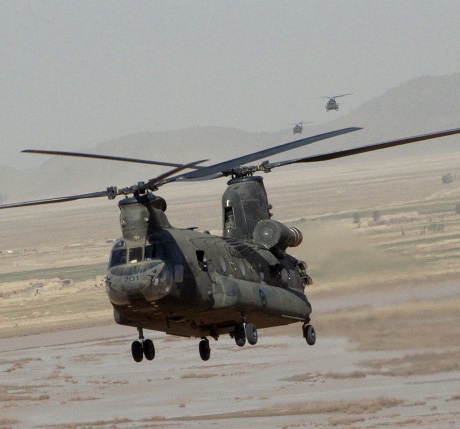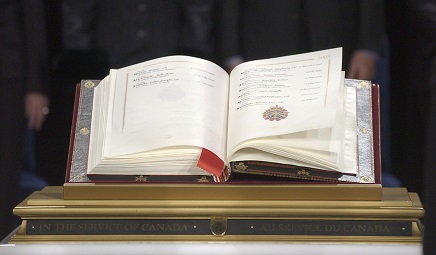The Cold War ends and the campaign against terrorism begins (1989-present) - part 6
The world changed on September 11, 2001.
On that day, terrorists used passenger jets to attack the World Trade Center in New York City and U.S. defence headquarters at the Pentagon in Virginia. The phrase “9/11” became as synonymous with treachery and brutality as “Pearl Harbor” has been since the Second World War. The democracies had entered a new era of military planning with a campaign against terrorism.
Beginning that same year, Canada began contributing military personnel to Afghanistan, the training ground for the 9/11 terrorists and a country that had suffered under the authoritarian rule of the Taliban.
FOCUS ON… THE CH-147 CHINOOK

Griffon and Chinook helicopters during a training mission in Afghanistan.
In 1991, Canada’s CH-147 Chinook helicopter was retired. 447 Transport Helicopter Squadron in Edmonton was disbanded and 450 Transport Helicopter Squadron in Ottawa became 450 Composite Helicopter Squadron (later 450 Tactical Helicopter Squadron), flying CH-135 Twin Hueys.
But you can’t keep a good helicopter down.
As a result of the “Manley Report”, Canada acquired CH-147D Chinooks from the United States to use in Afghanistan. Later, the Canadian Armed Forces began the process of acquiring 15 brand new CH-147F Chinooks to operate domestically and internationally. The new Chinooks began arriving in 2013 and delivery was completed a year later.

In 2005 the Canadian Armed Forces began the process of transformation to better meet the challenges of the modern world — the so-called asymmetrical threats best characterized by the attacks of September 11, 2001.
The Air Force had begun its own transformation process before Canadian Armed Forces-wide transformation was announced.
The Air Force defined its vision as “an agile and combat-capable aerospace force with the reach and power essential to integrated Canadian Armed Forces operations at home and abroad”.
The establishment of the Canadian Forces Aerospace Warfare Centre, release of Air Force doctrine, strategy and other keystone documents, equipment capitalization, a more robust presence in Afghanistan, modernization of Air Force occupations and training all contributed to the transformation of the Air Force to a modern, capable force for the 21st century.
In December 2008, the Air Force took a significant transformational step forward in becoming an expeditionary air force, with the stand-up of the Joint Task Force Afghanistan Air Wing. The wing was responsible for tactical medium- to heavy-lift helicopters, escort helicopters, tactical airlift in-theatre and tactical unmanned aerial vehicles.
During its three years of operation, the air wing carried Canadian and Allied troops and cargo in and out of theatre and throughout Afghanistan, thereby reducing the risks of movement by land. Its personnel also provided valuable surveillance and reconnaissance services, enabling commanders “on the ground” to make better decisions. Their presence saved countless lives.
The air wing stood down on August 18, 2011, as Canada withdrew from the combat mission in Afghanistan.
Individual RCAF personnel continued to serve in Afghanistan as part of Operation Attention, the Canadian contribution to the NATO Training Mission-Afghanistan.

On July 14, 2006, in Afghanistan, the Air Force parachuted supplies (including ammunition, food and water) to support combat troops for the first time since the Second World War.
FOCUS ON… THE 7TH BOOK OF REMEMBRANCE

Veterans Affairs Canada.
Seventh Book of Remembrance
In the Service of Canada, the Seventh Book of Remembrance, was dedicated on November 11, 2005.
It records the names of Canadian Armed Forces men and women who have given their lives in the service of Canada since October 1947, with the exception of those commemorated in the Korean War Book of Remembrance. It joined Canada’s first six Books of Remembrance, which record the names of Canada’s war dead. The books reside in the Memorial Chamber in the Peace Tower on Parliament Hill in Ottawa.
The seventh book is a living document, and names continue to be added. It’s especially poignant for the Royal Canadian Air Force (RCAF) because a large percentage of the people recorded in it are from the Air Force due to the inherent dangers of flying, whether in peace or war.